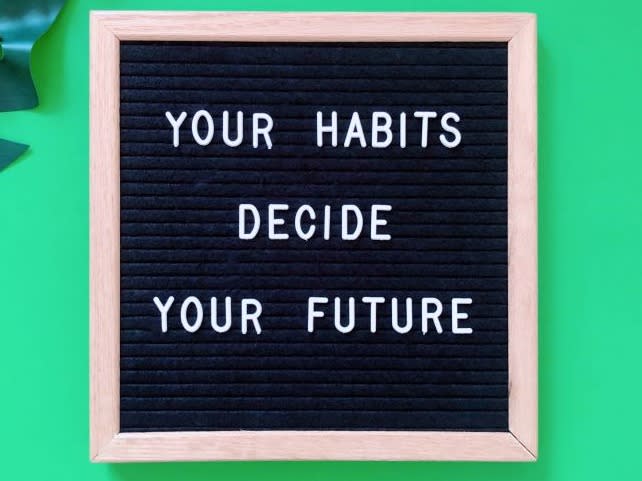
How To Use A Habit Loop To Stop Your Bad Habits
Jun 7, 2023
By Will Moore
Have you ever wondered why, despite your best efforts, you can’t seem to get out of your old habits?
You decide to change your diet and start eating more vegetables and whole grains. But then comes the next barbecue and pretty soon, you’re back on the daily dose of red meat.
After a visit to the dentist, you swear to yourself that this time, you’re going to floss every single day. But a few weeks later that floss is already gathering dust in the bathroom cabinet.
You decide to finally pick up that biography you’ve been wanting to read, but when you sit down on the sofa you automatically reach for the remote and before you know it, you’re watching reruns of some old show from the 90s.
I could go on and on with examples – and I’m not saying this to rub salt in the wound (ha! Too much salt in your diet could be another bad habit you’d love to kick).
I’d like you to take comfort in the fact that there are so many examples of failed good intentions to kick bad habits no matter how many of them resonate with you. It’s a sign that you’re a perfectly normal, functioning human being.
Another amazing thing about us humans is that we have the ability to look at ourselves from the outside and make a decision to change our behavior. I’m going to show you how your habit loops are the key to stopping your bad habits and replacing them with successful habits to gamify your life.
But first, we need to answer the question…
What Are Habits And Why Are They Important To Success?
When most people think of habits, they automatically conjure up images of the “bad habits” that they find difficult to “give up”. Well, that’s not how I see it. A habit is the result of a behavior that’s been repeated so many times that it becomes an automatic response. In fact, 43% of your daily actions are habits – carried out without any conscious thought at all.

Of course, when you look at it like this, you can probably identify hundreds of different habits that you’ve accumulated in many different areas of your life. So, we’re not just talking about your after-dinner cigarette here.
Or how you leave the dishes in the sink overnight. Habits include things as boring and mundane as always taking the same route to the office, which brand of cereal you buy, or whether you try the meat on your plate before the potatoes.
So, a “bad habit” isn’t something you have to “give up”, because that implies some level of sacrifice. Instead, think of replacing habits that give you an undesirable outcome with habits that move you more in the direction you want to go.
Following this reframed definition, we can break habits down into 3 very distinct types; neutral habits, failure habits, and healthy habits. It’s the collective accumulation of all your habits that will determine how much momentum and happiness you have in your life.
At this point, you may be thinking, “what’s the difference between a ‘success habit’ and a ‘failure habit’?”.
Well, it all comes down to the long-term and short-term benefits those habits give you.
Imagine this situation:
It’s mid-afternoon, still a few hours away from the end of your workday and you start to feel a little bored and tired. On your way to pour yourself a cup of coffee, you pass the kitchen cupboard or vending machine and decide that a chocolate bar or pack of cookies would go very well with that coffee. You even start to feel a little hungry as you think about it.
When you do that, you’re giving yourself a short-term benefit in the form of a satisfying hit of fat and sugar but in the long term, it will have a negative effect on your health.
That’s an example of a typical “failure habit” – one that only has a short-term benefit.
But how about if you had that same feeling of being bored and tired, but instead of coffee and sugar, you take a drink of water and a 15-minute walk around the block. Then, maybe you satisfy that mild hunger with a handful of mixed nuts or a piece of fruit.
In this case, you get the short-term benefit of relieving your tiredness, boredom, and hunger. But at the same time, you get the long-term benefit to your physical health.
So, “success habits” give you a short-term benefit to scratch the itch, while also giving you momentum toward achieving longer-term goals.
In both these scenarios, the habit was triggered by the same set of circumstances (boredom, tiredness, hunger, time of day, office environment, etc) – but having a “trigger” and a resulting “behavior” doesn’t necessarily mean you have a “habit”.
Read More: Feeling Lost in Life
So, How Are Habits Actually Formed?
As I mentioned before, habits are the result of behavior that��’s been repeated so many times it becomes an automatic response that you carry out without thinking. So, the answer to how habits are formed lies in repetition.

Every time you repeat something you’ve already done before, you activate a specific neural circuit in the brain associated with that action. Every time that neural circuit is activated, it becomes a little stronger. After a while, that neural pathway becomes so strong that it takes no conscious effort at all to activate – that’s how habits are formed in the brain. And this relates to the concept of habitualization.
Breaking that habit and replacing it with a new one is going to start with a conscious decision to do something differently. Then it’s going to take conscious effort as you gradually alter the neural pathway that connects the “trigger” e.g feeling tired with the “behavior” e.g. taking a short walk.
There are techniques, like habit stacking, that you can leverage to speed up and simplify that process. But to really understand how habits are formed (and how you can use them to create momentum and happiness in your life), we’ll have to go a little deeper and talk about something called a “habit loop”.
What is a Habit Loop?
Your brain is a highly-advanced problem-solving machine. It’s evolved over thousands of years to make decisions that keep you happy, healthy, and safe. But making decisions takes up a lot of energy, so your brain has also evolved a way to save those decisions for the future – and free up that energy for making new decisions.

The way your brain achieves this miraculous result is through something called a reward-based feedback loop. Every time your brain makes a decision (solves a problem), it receives a reward and a new neural pathway is formed.
When it comes to habit formation, the process is very similar. Habits are formed through 4 steps that create a feedback loop, this is the “habit loop” that was first written about by Charles Duhigg and later expanded by James Clear. This is how habits work.
Read our blog on Dopamine Texting
The 4 parts of a “habit loop”
The “habit loop” consists 4 parts that are: cue, craving, response, and reward.
Step 1: Cue
The cue is the trigger that kicks the whole process off. Identifying the cues that trigger your failure habits is a critical step in replacing them with new habits that are good.
Your habit cues will come in all shapes and sizes but there are generally only 5 kinds of habit triggers that you need to recognize.
Step 2: Craving
The craving is an interesting part of the habit loop. It’s that sense of curiosity, urgency or anticipation that’s almost impossible to ignore.
Just remember the last time you got hunger pangs out of nowhere when you smelled fresh bread or cookies baking in the oven and you’ll know exactly what I’m talking about.
Cravings are different for everyone, so self-awareness is key to identifying them when they show up.
Step 3: Response
The response is the automatic habitual behavior or routine that you fall into. Whether that’s picking up your phone, walking to the refrigerator, brushing your teeth, or even a thought that jumps into your mind. These are all habitual behaviors or sometimes called routine behaviors.
Step 4: Reward
The final step is the one that determines whether this process will lead to a habit (and the reason it’s a habit “loop”). The reward is the driving force behind each step of the process:
The cue is about noticing the reward.
The craving is about wanting the reward.
The response is about obtaining the reward.
The emotions that you attach to the reward – like pleasure, relief, disappointment, or disgust – will determine whether your brain saves this particular chain of events as something to avoid or something to pursue.
And that’s how this “process” becomes a “feedback loop” that leads to habit formation.
I recommend listening to this post, How to Achieve Perosnal Success?
Habit Loop Examples: Let’s Take a Look At Habit Loop in Action
Imagine you’re sitting at your desk working on your current project and your phone vibrates.
Immediately, you’re struck with curiosity and before you know it, you’ve stopped working and you’re reaching for your phone. You unlock it and see a message from your friend asking if you want to grab dinner tonight. You feel a sense of happiness, belonging and connection and a big smile creeps over your face as you type out your reply.

In this case, the cue is the phone vibrating on your desk.
The craving is the sense of curiosity.
The response is you reaching for your phone.
And the reward is the positive emotions you get from connecting with someone you care about.
So next time your phone vibrates, your brain anticipates the positive reinforcement, and the whole cycle is reinforced.
In this example, the cue was an event (the phone vibrating).
How To Hack Your Habit Loops To Replace Your Bad Habits With Healthy Habits
The golden rule when it comes to hacking your habit loops to change your habits is simple: Keep the Cue, Craving, and Reward – but change the Response.
It’s that simple!

When you identify a failure habit that you’d like to change, try to figure out the 4 different parts of the loop that keep it running. Then we can use a scientifically proven method to change the ‘Response’ part of the habit loop and create an implementation intention, basically a simple “if - then” statement that clearly shows your intention to change.
Let’s use the example from earlier:
In the mid-afternoon at work, you start to feel tired and bored (Cue).
You get an urge to grab a coffee and something sweet (Craving).
You walk to the kitchen and vending machine (Response).
Your energy levels increase and your boredom is temporarily relieved (Reward).
In this case, an implementation intention statement might be: When I feel tired at 2 PM, I will get up and walk around outside for 15 minutes.
Now write the statement down somewhere you’ll be able to see it next time that craving kicks in.
A Final Note on Creating Success Habits using a Habit Loop
I believe that the key to sustained happiness, fulfillment, and momentum in life lies in building good habits in 5 core areas of life:
Your mindset
Your career & finances
Your relationships
Your physical health
Your Mental health
Your emotional state
Before you can identify bad habits and replace them with success habits, you need clarity on WHERE you currently stand – and WHAT you actually WANT to achieve in these 5 areas of life.
To help you get started, I designed this simple quiz. Find out how happy you are right now and in which of the 5 cores you need to focus on building success habits to step into the pilot seat of your rocket and fire on all cylinders.
Want to know where you stand in the five values of life tied to happiness (your five cores)? Take this two-minute Core Values Quiz to get your core score in the five values of life.
